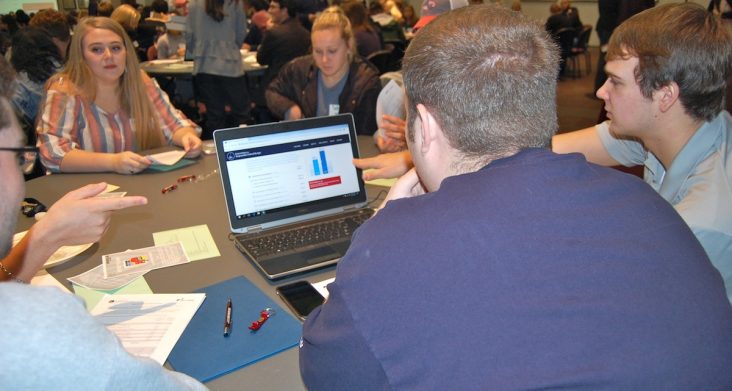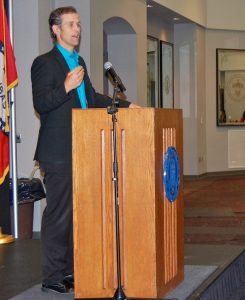Students use tax increases, spending cuts, tough ‘trade offs’ to reduce national debt
by October 14, 2018 1:41 pm 866 views

University of Arkansas at Fort Smith students use the online “debt fixer” tool to find ways to reduce the national debt. The online tool was created by the Washington, D.C.-based Committee for a Responsible Federal Budget.
More than 220 University of Arkansas at Fort Smith students gathered Friday (Oct. 12) to devour 64 large pizzas and consider ideas on how to trim the national debt by almost $8 trillion in the next 10 years.
First National Bank of Fort Smith, UAFS and the Washington, D.C.-based Committee for a Responsible Federal Budget (CRFB) hosted the “Debt Fixer” event held 11:30 a.m. to 1 p.m. in the Reynolds Room of the Smith-Pendergraft Campus Center on the UAFS campus. The event was open and free to all UAFS students.
The CRFB, formed in June 1981, is a non-partisan group that works to educate the public on federal budget issues. The group also works with members of Congress to provide analysis and other information on the country’s fiscal condition.
Each of the 30 student groups had a laptop to use the Debt Fixer, an online tool provided by the CRFB, to consider how to reduce the national debt. Areas the students considered include healthcare spending (Medicaid and Medicare), defense spending, Social Security, farm bill budgets and other domestic spending.
Mike Murphy, CRFB chief of staff and director of strategic initiatives, said in an interview prior to the event it’s important for university students to become more aware of the debt problem.
“Students are the core audience that needs to hear this message. They are the ones who are going to be disproportionately affected and burdened if we don’t do something about this. So we really need students to get engaged,” Murphy said.
He said political leadership in both parties is not likely to address the debt issue unless the public demands it.
“Washington is incredibly polarized. The debt has in many ways come to symbolize the brokenness of our political system. The public needs to get engaged. The public needs to get engaged to understand these issues and pressure our policy makers to move beyond their partisanship and actually come together and work out solutions to this problem,” he said.
And while the debt issue is “not exactly sexy,” and doesn’t get much time in the “very short-term focused mentality in this country,” Murphy believes trillion-dollar annual deficits will place more focus on the issue, and it will be a frequent topic in the upcoming presidential election cycle.

Prior to students using the debt fixer tool, Murphy conducted a brief review of the nation’s fiscal situation. He noted that the federal government would in fiscal 2018 collect $3.3 trillion in revenue and spend $4.1 trillion, with the overall national debt reaching $21 trillion. The fiscal year 2018 deficit was around $782 billion, up from $666 billion in fiscal 2017. Murphy said annual deficits will reach $1 trillion by 2020.
He also noted 47% of the national budget funds critical social programs Social Security (24%), Medicare (14%), and Medicaid (9%).
Students then spent about 45 minutes working in 30 groups with the online debt fixer tool. The primary effort required finding $7.81 trillion in cuts or new revenue in the next 10 years to reach the CRFB target goal of reducing national debt to 70% of GDP in the next 10 years, and down to 40% by 2050.
Zach Moller, a CRFB senior policy analyst, reported a “vast majority” of groups reached the CRFB target goals. He said almost every group said the government should work to reduce prescription drug costs. Also, 84% cut spending by ending the wars in Iraq and Afghanistan, 79% raised revenue by increasing cigarette and alcohol taxes, and 50% reduced spending by cutting foreign aid. Moller said only 11% selected to extend the new federal tax law that will expire at the end of 2025. The tax cuts enacted in that law have added to the annual deficit. Almost all groups used a combination of tax increases and spending cuts to meet the target goal.
Several students who spoke after using the debt fixer tool noted the numerous tough “trade offs” each group had to discuss to meet the goals.
Sam Sicard, president and CEO of First National Bank of Fort Smith, told the students they just completed an exercise politicians in Washington, D.C., avoid.
“Those trade offs, those hard choices, are not happening there,” Sicard said.
